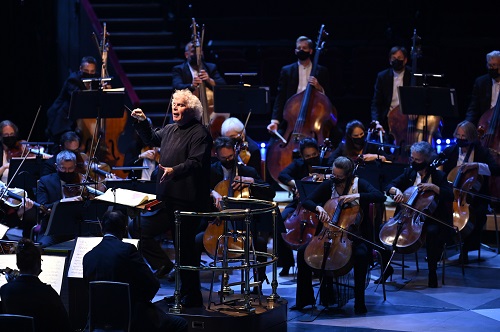
 United Kingdom BBC Proms 2021 [14] – Stravinsky: London Symphony Orchestra / Sir Simon Rattle (conductor). Royal Albert Hall, London, 22.8.2021. (CS)
United Kingdom BBC Proms 2021 [14] – Stravinsky: London Symphony Orchestra / Sir Simon Rattle (conductor). Royal Albert Hall, London, 22.8.2021. (CS)

Symphonies of Wind Instruments; Symphony in C; Symphony in Three Movements.
Igor Stravinsky: symphonist. The London Symphony Orchestra’s programme marking the 50th anniversary of Stravinsky’s death might have seemed designed to grant the Russian master of renewal and re-invention an uncharacteristically singular, definitive nomer. Simon Rattle – who will continue as the orchestra’s Music Director until 2023, whereupon he will assume the role of Conductor Emeritus – chose for the LSO’s 2021 Proms appearance three of the five works to which Stravinsky accords the description ‘symphony’ or ‘symphonies’: the terse Symphonies of Wind Instruments (1919-20), the neoclassical Symphony in C (1938-40) and the … Symphony in Three Movements (1942-45).
Had Rattle included the Symphony in E-flat from the composer’s student years, and the Symphony of Psalms (1930) we’d have had a full set. And, one might argue that the Symphony of Psalms – which the LSO substituted for Symphonies of Wind Instruments in their Stravinsky triptych with Michael Tilson Thomas on the Sony Classical label in 1991 – offers a spiritual depth that is lacking in the neoclassical works, and blends voices and instruments in what might be considered a truly symphonic manner. But, circumstances and concert challenges being what they are at present, the decision not to involve vocal forces is understandable, even if the Psalms would also have made for a full evening of music. As it was, the three works – the shortest about ten minutes, the longest just under thirty – formed a little over an hour of music and were performed side by side with no interval. This distillation and focus proved considerably advantageous though, in that Rattle did not so much as shine a spotlight on Stravinsky’s methods as fine-tune a microscopic lens on an ‘essence’ that we might sense at the heart of the composer’s protean creativity.
The Symphonies of Wind Instruments is not a symphony in a formal sense, rather an assemblage of symphonies of sound: timbre is inseparable from rhythm, both are inextricably fused as musical architecture. Dedicated ‘To the memory of Claude Achille Debussy’, it was originally published as a chorale for solo piano in a memorial anthology. No authentic score of the 1920 version of the Symphonies was published in Stravinsky’s lifetime and in 1947 the composer revised the work, the latter edition being the most commonly performed.
Rattle opted for the 1920 version of the score, however, and so we enjoyed the softer sounds of alto flute and basset horn which were later omitted, and the warm horn and clarinet sonorities which are favoured in the earlier version over the reedy oboes and cor anglais in the second. Stravinsky presents ‘blocks’ comprising endless combinations of colour and texture, in alternating registers and tempos. Each block is unique, such that the work is like an oral colour chart. Indeed, so finely distinguished were the sonorities crafted by Rattle and the LSO wind players, that Symphonies seemed almost like a constructivist painting, highlighting Stravinsky’s technical mastery in organising his material.
Yet, each timbral grouping was affectionately crafted. A silkily blended flute quartet contrasted with the piquancy of high-spirited clarinets; trumpets pranced pertly and with a lovely pure tone; alto flute and bass clarinet meandered smokily; the rich brass were as soft as a baby’s blanket; low pulses from tuba were a call from an archaic past. There was a perfect balancing of the myriad tints in every hue. The groups of instruments rarely overlap, but here the transitions seemed seamless; occasionally the merest breaths between them signalled discipline and calm. There are complex tempo relationships in operation, but the motion seemed unwaveringly ordered, the ever-changing patterns transfixing. The precision and clarity, allowing us to hear the moving, winding inner parts, was astonishing.

Stravinsky described Symphonies as ‘an austere ritual which is unfolded in terms of short litanies between different groups of homogeneous instruments’, and Rattle and the LSO musicians really did evoke a sense of alternating supplications and responses, the parts forming a stately, sombre processional, disjunct at times but always sure of its final destination. And, so, the echoes of Russian folk music and the Orthodox liturgy were fused in the soul of the final chorale-like block that takes up much of the second half of the work. When motion gave way to stillness, there was not melancholy or mourning, but peace.
The Symphony in C was composed at a time of personal tragedy and trauma for Stravinsky: the deaths of his daughter, wife and mother were compounded by the growing threat of war which convinced him that another migration, from Europe to the US, was necessary. The work, commissioned to mark the Chicago Symphony Orchestra’s 50th birthday, straddles the Atlantic: the first two movements were written in 1938-39, in France, the last two in the US, during 1939-40. This might be a ‘standard’ symphony – four orthodox movements – for an orchestra that Beethoven would have recognised (with added tuba) but there’s a terseness in Stravinsky’s handling of motif and development that is quite different from Beethoven’s methods, despite the Fifth Symphony’s four-note hammering that Stravinsky seems to echo at the start of the first movement.
Again, the woodwind dominate, and there was some very fine oboe, clarinet and bassoon playing to enjoy here. The string sound was wonderfully unified and strong: the players were masked but, two to a stand, not socially distanced. Overall, though, I found Rattle’s reading a little too staid: the tempo of the opening movement seemed a touch slow, the driving scalic passages rather heavy. Yes, the rhythmic energy was high, the structure taut, the inner workings once again pristinely exposed; but it felt rather cerebral, and I missed a certain ‘freshness’ and ‘flow’.
The lightly scored second movement was more gracious, Juliana Koch’s oboe solo sweetly expressive above the pizzicato lilt and string flutters. This gentle dance closed with a lovely duet for Koch and bassoonist Rachel Gough, before it was shoved rudely aside by the brassy punch of the scherzo. Here, again, the tempo seemed a tad careful, so that the waywardly changing meters didn’t seem quite as risky as they might. Rattle certainly made sense of the busy bustle, but it sometimes felt a little dry. Horns and bassoons swirled dark-hued paints at the start of the finale and from this rich soup launched incisive, gritty racing scales. But, by the coda, when the wind unfolded a dignified procession of chords, we seemed back in the spirit of the Symphonies of Wind Instruments¸ the neoclassical rakishness a little dampened.
The Symphony in Three Movements shares much with the works that preceded it here; blocks of juxtaposed material and sound; tight temporal divisions and relationships; complex rhythmic arguments; wind-dominated sonorities and solos (though now with piano and harp share the limelight too). But, from the proud unison statement which opens the first movement, the Rattle and the LSO conjured a boldness that seemed to harken back to Stravinsky’s earlier Russian period. Classical grace was swept aside by baying horns and brass, and bellicose timpani; slicing string accents had a steely edge. The music threatened to be unpredictable even as Rattle kept everything on a tight rein, sharply defined and punchily crisp. Again, perhaps the tempo might have been turned up just a notch, but Rattle sustained the urgency through the chugging ostinatos and brought forth every detail, particularly so during the central concerto grosso-like episode where piano and woodwind engaged in fugato-like conversations, lean and lithe, which the strings softened with their gentler interjections.
The Andante was a calm intermezzo, the energy quelled by the harp, though sonorities were once again sharply juxtaposed and the three-note ostinato kept on rolling. The textures were transparent and fresh, as if Rattle had pulled back the curtains and let the light shine on the orchestral innards. But, just when tender strings suggested that the music might finally relax, aggression swelled up as if from nowhere, and physical ruggedness and power once more reigned, in the ‘goose-stepping’ gestures which open the final movement. Jagged, rasping, unyielding, the finale was vivacious, even brash. A brilliant conclusion to a concert which illuminated the inner coherence of each of the three ‘symphonies’ and the connections between them. No wonder the evening concluded with a good old Prommers’ stamp of appreciation.
Claire Seymour
This concert is available on BBC iPlayer and BBC Sounds.